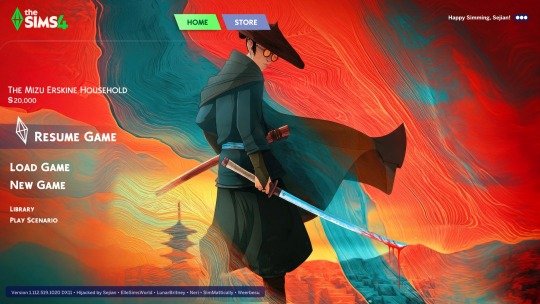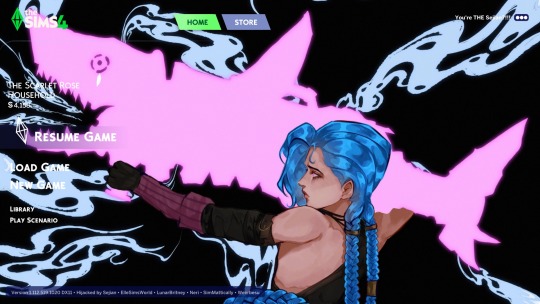#Wholesale Party Tops
Explore tagged Tumblr posts
Text
pissing shitting crying myself because im tryihng to do the mcyt classic of 'taking one video way too fucking seriously as a narrative' but am immediately thwarted by the fact its actually mario party
#I Am Normal And Can Be Trusted With The RT Ray Jocat And Shen Mario Party Video (affirmation)#ive watched ray and jocat on and off since middle school#and was a top 0.1% rt viewer this year#so like!!!! itgs doing so much for me and i wanna do the Serious Narrativization to like. honor it#but im getting caught on the fact it has just. no consequences JFSLJ#like everyones fine winning or losing and everyones friends and i wanna KEEP it that way#ray can be an antagonist but never an enemy yknow?#but removing both stake and tangible reward means like. theres Nothing There augh idk#just part of the marinating process. best i got rn is friendly competition for like. nomination#inh my head its vaguely royal but i do think thats wholesale made up on my end#anywayyy#fun fact ray is the first person who i knowingly stole the personality from to build my own
5 notes
·
View notes
Text
How French Fries Became India’s Favorite Snack After Samosas – Funwave Foods LLP

For decades, samosas ruled the Indian snack scene. Whether it was a street-side stall or a family function, no snack came close to its fame. But today, there's a new favorite on the plate—French fries.
From cafés to canteens, weddings to quick-service restaurants, French fries in India have become an everyday essential. And at the heart of this snack revolution stands Funwave Foods LLP, the best French fries brand in India.
Why Indians Love French Fries
There are many reasons why fries are now one of the most popular snacks in India:
They’re crispy and easy to customize
They’re quick to cook and serve
They match perfectly with Indian flavors—peri-peri, chaat masala, or even cheese
French fries don’t just taste great—they’re also perfect for busy kitchens, including restaurants, hotels, and catering services.
From Side Dish to Star Snack
Earlier seen as a side for burgers, French fries now stand strong on their own. In fact, many QSRs and cafes sell fries in multiple flavors, portions, and packaging styles.
Ask any food business owner, and they’ll tell you—frozen French fries for restaurants are a must-have on the menu. They’re fast, cost-efficient, and customer favorites.
Even in events like weddings and parties, fries often replace samosas thanks to their convenience and modern appeal.
Who’s Leading the Fry Game? Funwave Foods LLP
When businesses look for the top frozen snacks exporters or bulk French fries for hotels, they turn to Funwave Foods.
Here’s why:
✅ Leading French fries manufacturer in India ✅ Reliable frozen French fries supplier for hotels, QSRs, and caterers ✅ Bulk supply for Indian weddings, parties, cafés, and events ✅ High-quality, long-cut and crispy French fries ✅ Trusted exporter of frozen French fries from India
Whether you run a local café or manage international supply chains, Funwave Foods delivers bulk quality fries with consistency and trust.
Why Choose Funwave French Fries?
Ideal for restaurants, school canteens, caterers, and cloud kitchens
Sourced and processed in state-of-the-art facilities
Made for quick frying and maximum crispiness
Available in bulk for food service businesses
Looking for the best frozen food suppliers in India? Need French fries wholesale supplier for your business?
Funwave Foods LLP is your one-stop solution.
The Verdict
So, are French fries more popular than samosas in India now? The answer is simple—both have their place, but fries have found new fans in modern India.
With Funwave Foods LLP, you get not just fries, but a partner who understands food business demands.
📦 Visit: https://funwave.in 📞 Connect with us for bulk orders and exports.
#French fries in India#Indian snacks#French fries manufacturer India#Frozen French fries supplier#Best French fries brand India#Top frozen snacks exporters#French fries wholesale supplier#Bulk French fries for hotels#Frozen French fries for restaurants#Where to buy French fries in bulk#Exporter of frozen French fries from India#Snacks for Indian weddings and parties#Best frozen food suppliers in India#How French fries became popular in India#French fries vs samosa#Why do Indians love French fries#Most popular snacks in India
0 notes
Text
How to Choose Comfortable and Stylish Women’s Slippers?
Finding the perfect balance between comfort and style when it comes to women’s slippers can be a game-changer for your daily relaxation and fashion-forward moments. Whether you’re lounging at home or stepping out for a casual outing, the right pair of slippers can elevate your comfort while making a style statement says Ms. Shradha Wadhwa, CEO of Cindy Footwears, India’s leading ladies’ slippers brand.

How to choose a comfortable and stylish slipper for women?
Here is a guide from Ms. Wadhwa to help you navigate the world of women’s slippers, with a special spotlight on the fabulous offerings from Cindy Footwears.
1. Comfort is Key: Opt for Quality Materials
The foundation of any comfortable slipper lies in its materials. Look for slippers made from soft and breathable materials that pamper your feet with each step. Cindy Footwears understands the importance of comfort, and their slippers for women are crafted with precision using high-quality materials to ensure a cozy and enjoyable experience for your feet.
2. Arch Support for Happy Feet
Comfortable slippers should provide adequate arch support to prevent discomfort and fatigue. Cindy Footwears’ slippers…
Read Here: https://cindyfootwears.com/Blog/choose-comfortable-stylish-womens-slippers/
#buy shoes online#cindy footwears#buy women's running shoes online#buy sandals online#india's top ethnic footwear brand for women#india's top footwear brand for women#sneakers#buy bridal shoes online#buy shoes for women#women casual shoes#women party shoes#women formal shoes#women wedding shoes#women ethnic shoes#wholesale shoes#shoes for women#casual shoes for women#ladies shoes
1 note
·
View note
Note
What would you say is the main responsibility/task of each communist party in each european country nowadays? How would the whatever task be done? While this of course differs with every country, I've often thought about this bc of the lack of support the communist party in my country gets. On top of me only just having started organizing and being inexperienced I often ask what I should do when me and my comrades genuinely don't have a lot of support anywhere, especially among workers (who are mostly nationalistic right wingers or centrists). Thank you if you decide to answer, I appreciate hearing your thoughts bc of the way you articulate things and bc of your experience within your own party
Broadly speaking, the main priority is achieving political independence and recognition.
Most of Europe has a context of historical communist parties getting whatever flavor of reformist deviation last century, resulting in the struggle of new parties (such as the PdA in Austria) to be recognized as separate organizations from the historical parties (KPÖ in this case), even when the historical communist party doesn't even exist anymore (the case of the NCPN in the Netherlands). This has nuances or course, the Swedish marxist-leninists, for instance, have managed to constitute themselves with the same name as the historical party (SKP). In eastern Europe, this is further complicated because communist parties are either wholesale banned or struggle a lot with the demonized legacy of the ruling communist parties from the cold war. Ukraine's UCU and many other similarly communist parties have faced considerable state violence, with the case of the Kononovich brothers being recent.
By political independence I mean being able to articulate the class interests of the proletariat on any given relevant issue, avoiding tailism and ceding ground to the logic of reformism, lesser-evilism, social peace, etc. Both of these issues have been, at this time best overcome by the KKE.
Recognition and independence to hand in hand, you could be the smartest marxist in the continent tucked away in some corner of the internet writing pages upon pages of excellent analysis, but if nobody recognizes you and your party as dependable and a serious organization, you might as well be masturbating over a copy of Capital.
This is solved by becoming a consistent ally of the working class in every single struggle you are able to, from the most immediatist to the most revolutionary. And on top of this, it is crucial European parties recover the focus on work as the base of their work. The student, housing, queer, etc. movements will have varying importance depending on time and place, will be more or less permeable to communist positions, and it'll be more or less useful to participate in them. But the worker's movement, whose mobilizations always have a direct relation with the mode of production and capitalism's prime contradiction, should at all times be the focus of any pretension of revolutionary work.
As time passes, a party will become a recognizable and trusted ally of the working class, by virtue of constructing that political independence, our work will always be consistent in its goal and interests it defends. Social-democrats, anarchists, worker's unions, will in some form or another falter in their support, due to the influence of bourgeois interests in their politics. If a party fails to continuously and consciously constitute its political independence, it will also falter and the workers' confidence will be eroded. If you imagine worker's mobilizations like a river that periodically swells up to flood everything in its path, and that at other times is an imperceptible stream, a communist party should act like sediment. It is not external to the river, it is an inextricable component part of it, the solid matter that, after a flood, when the river shrinks back down, remains in its path. It doesn't disappear, it's the memory of the previous courses the river has taken, and the size it achieved. When the river swells up again, it'll do so treading on the path marked by the sediment.
Though the experience of the workers' own immediatist struggles, in which the untrustworthiness of worker's unions and social-democracy especially eventually becomes relevant, having the communist party as a referent, a handful of communists who have lived and breathed the same victories, defeats and betrayals as the rest of the workers, a small hegemony of communist positions can begin to appear. If people begin to trust communists and our ideas again, it'll be because their own experience will show that, eventually, the only remaining dependable faction is the politically independent communist party. The same can be achieved in other movements. For instance, in my university, the communists have become the referent organization for matters of security and organization of structures, after years of consistently being the most trustworthy organization in those matters. The as of yet relatively small sympathy students and workers have acquired towards us and our political analysis has been gained through this, not by simply being the most correct.
Another essential foundation is that of internationalism. The propaganda of warmongers and violent xenophobes which is permeating the working class and making things such as an expanded military budget spurred by NATO and the EU, or stricter control over Europe's borders more palatable, must be faced directly and without pretensions. Solidarity work with migrants and our armies' victims beyond the Mediterranean is becoming increasingly crucial. And, once again, political independence is a prerequisite.
A common issue that springs from the small size of almost all marxist-leninist parties in Europe is that their work is predominantly agitative. Doing that kind of work I described above requires a number of hands and heads able to dedicate significant parts of free time towards those goals, so gaining new members becomes a top priority. It's a difficult cycle to get out of, growing requires actual work to be done, which requires a considerable amount of manpower for these small parties. But it is not an infinite cycle, though it may look futile, even a consistent small amount of work will eventually attract someone new. If the structure of the party is able to sustain itself with a minimum amount of members, growing becomes a question of ingenuity and time, less or luck (although luck is still involved).
Politics is a reflection of the state, at any given time, of the material conditions that continue the exploitation of our class. Therefore, only attempting to change it from the tail end, political discourse by itself, is useless. Parties must attempt to first act on the relations of labor itself, as close to the core mechanisms as possible, so that its political independence is possible, it can hold water, and it becomes a small part of the political sphere "downstream" from the relations of the organization of labor. If you want to convince workers of how chauvinism and racism is antithetical to their interests as workers, what's only going to work reliably and at a bigger scale than individuals is to be the only dependable ally in worker's struggles, holding internationalist positions. A party's positions can only be referential once its work is referential.
Tactics, then, become dictated by the needs of organizing in your own context. Perhaps participating in elections is useful to garner some recognition and use the electoral period as an opportunity for agitation, or perhaps it's more useful to ignore elections altogether. In my opinion, there is no European country where it isn't worth it to use the platform of elections, presupposing the party in question understands it is using elections, not earnestly attempting to govern some facet of the bourgeois state, although it is perfectly possible this will change in the future. Similarly, perhaps it is useful to participate in the worker's unions as a "red fraction" within it, to facilitate the party's participation in the worker's movement like I explained earlier, and without losing a clear criticism of the unions and their unreliableness, or perhaps it's better for parties to control/create a union itself. For smaller parties, generally speaking, the red fraction strategy is much more preferable. The KKE, for instance, has its own union, PAME.
In summary, the priority is political independence, with a stress on internationalism, that is only legitimized by the recognition gained through consistent organization, first in the worker's movement, through whatever means are deemed worthwhile, avoiding dogmatism, tailism, and disconnection from the reality of the working class in each country.
113 notes
·
View notes
Text
🎁 [BG] SGFX + Resource Override - Main Menu + Custom Background Template + Camera Angles
☠️ REMINDER: Double-check the OP for updates!






⚔️ Requires - TS4: Base Game
🌠 New Arrivals - 2/5/2025
☄️ Updated - NIL
🚀 Initial Release - 2/4/2025
🎁 Download & Discussions: https://www.patreon.com/posts/121348052
🗺️ Modding Announcements: https://www.patreon.com/posts/109291501
🪄 My SGFX Overrides Collection: https://www.patreon.com/collection/1306589?view=condensed
💬 This isn't as straightforward as it looks. This is a collection of mods meant to make your journey simpler. It includes:
STEP 1 (MANDATORY) - Download the SGFX Override what primes the Main Menu for custom backgrounds, PERMANENTLY HIDES the Household thumbnail, and adds the Household and News/Marketing "toggle" found in other third-party overrides. Press "S" to toggle.
STEP 2 (OPTIONAL) - Grab one of my two Camera Angle Patches for the SGFX Override what re-enables the Household thumbnail (when toggled) in two different camera angles - a closer and lower front-facing "LONG SHOT" and a tweaked top-down isometric "HIGH ANGLE". You have the choice between a cute isometric angle and a boring standard front angle for your Household thumbnail. 🌠 An additional "NO HOUSEHOLD" patch is included for use with third-party overrides.
STEP 3 (OPTIONAL) - Grab my D.I.Y. Custom Background Template (A.K.A. my Resource Override) so you can make your own custom backgrounds. All you need to do is ensure my SGFX Override is up to date and your backgrounds will always work. Technically, these resource overrides might work without an SGFX override if you are in Offline Mode because that's how the EAxis code is configured. These resource overrides will work with other third-party Main Menu Overrides, but might require renaming for load priority (load order) if those overrides contain custom backgrounds - yes, it's this simple. It will work with @ellesimsworld's template with renaming and @lunarbritneyy's Online Backgrounds Disabled override, but it will not work with @simmattically's Refreshed Main Menu because that's a different beast entirely.
STEP 4 (OPTIONAL) - Grab a custom background by yours truly in 16:9 (1080p) widescreen resolution or 21:9 ultrawide resolution. EAxis broke image centering on the Main Menu in Update 1/14/2025 and I don't know if they fixed it yet, but those of you with ultrawide and oddball resolutions should not have to suffer. If you need a different resolution, just ask.
💬 F.Y.I. No, this does not allow you to swap backgrounds with a hotkey. That's a @simmattically special unless I'm mistaken and I ain't about to wholesale lift another creator's invention. You will have to manually swap these custom backgrounds. The one with load priority will appear in-game, so you can technically create a sub-folder wherever you have these and move the one you want to see into that sub-folder and the game should load it first. If that fails, you can rename the one you want to be alphanumerically ahead of the others, or you can ".packageOFF" disable the ones you don't want, or you can just move them in and out of your Mods folder.
💬 Every piece of artwork or promotional image I share will be credited in the Patreon post.
📸 The internet is horrible right now:





#sejianismodding#sejian ts4 sgfx override#sejian ts4 resource override#sejian ts4 tuning override#the sims 4#ts4#sims 4#the sims 4 cc#ts4cc#ts4 cc#sims 4 cc#the sims 4 custom content#ts4 custom content#sims 4 custom content#the sims 4 mods#ts4 mods#sims 4 mods#the sims 4 ui mods#ts4 ui mods#sims 4 ui mods#the sims 4 main menu#ts4 main menu#sims 4 main menu
21 notes
·
View notes
Text
TOKYO (AP) — Rice is essential to Japanese culture, tradition and politics. People take pride in the oval-shaped sticky Japonica grain, which is still a staple even though total consumption has fallen over the decades.
But since last summer, prices have soared as supplies have fallen short of demand. The government has long paid farmers to cut back on rice acreage, and change to other crops to keep rice prices relatively high.
To cope with shortfalls this year, the government has released rice reserves. But the grain has been slow to reach supermarket shelves. Anger over that was part of the reason the agriculture minister quit this week.
Consumers are frustrated and wondering where’s the rice?
Why did the farm minister resign?
Agriculture Minister Taku Eto resigned Wednesday after he raised an uproar by saying he “never had to buy rice,” because his supporters give it to him as gifts.
The remark was seen as utterly out of touch with the realities of ordinary people struggling to make ends meet and to afford rice to eat. Eto apologized, but he was obliged to step down as damage control by Prime Minister Shigeru Ishiba, whose minority government faces a big challenge in a crucial national election in July.
Eto's successor is former environment minister Shinjiro Koizumi, who has taken part in reforming Japan's powerful agriculture lobby. He's been tasked with investigating and resolving the rice problem.
What's happening to rice in Japan?
Rice started disappearing from supermarket shelves, and prices surged to twice normal levels since last summer, when a warning about a possible “megaquake” triggered panic buying.
The top “Koshihikari” brand now sells for nearly 5,000 yen ($35) per 5 kilograms (11 pounds). Rice stocks at Japan Agricultural Cooperatives and other commercial wholesalers have been 400,000 tons short of last year's levels, hitting a record low 1.53 million tons as of June, farm ministry data show.
The sense of urgency over shortages has risen now that rice crops have just been planted, with harvests several months away.
Why is Japan having rice shortages and soaring prices?
Ishiba has pledged to bring the average rice price down to about 3,000 yen ($20) per 5 kilograms (11 pounds).
“We don't know why we haven’t been able to push prices lower," Ishiba said during parliamentary questioning on Wednesday when asked how exactly his government will resolve the problem. “We first will figure out exactly how much rice there is and where it is."
He acknowledged that current measures aren't working and blamed "structural problems” of the government's rice policy.
Experts say last summer's panic buying just worsened longstanding problems. A sharp rise in tourism and an increase in dining out have raised demand.
Some people started eating more rice after prices of bread and noodles rose when the Russia-Ukraine war pushed wheat prices higher. And the 2023 harvest was relatively poor because of hot weather and pests.
Japan’s rice supply chain is complicated. Most farmers still sell their rice in the traditional system run by Japan Agricultural Cooperatives, or JA, a powerful interest group with close ties to the governing Liberal Democratic Party.
But a growing share is sold through other businesses and online, making it hard to track supplies and prices, said Masayuki Kanamori, an executive of the National Federation of Agricultural Co-operative Associations, a JA umbrella organization.
The shortage caught JA by surprise, Kanamori said.
“Looking back, the current rice shortage was unforeseeable,” he said. "We are puzzled.”
What's been done so far?
The Agriculture Ministry is under fire for delaying releases of emergency rice reserves, which normally are kept for disasters, and for misjudging the demand-supply balance. So far, only 10% of the released rice stocks have reached the market, raising suspicions about what's happening.
Koizumi on Thursday announced plans to switch to voluntary government contracts for rice to better control prices and to lift a cap on the next sale.
One problem may be a lack of enough milling capacity to turn the stocks of brown rice kept in reserves into the pure white rice that Japanese prefer. But others have accused some wholesalers of hoarding rice to keep prices higher.
So far, the government has done little to investigate and resisted releasing reserves, fearing prices would fall, Kazuhito Yamashita, research director at the Canon Institute for Global Studies.
Japan could have avoided the problem by allowing more rice to be planted and exporting more if there were surpluses, he said.
“Acreage cutbacks are contrary to food security, a ruinous policy," Yamashita said. He said that the policy benefits JA by keeping small farmers afloat.
Meanwhile, farmers coping with rising costs say prices aren't too high.
Ultimately, Japan will need to figure out a long-term strategy since the average age of its farmers is 69, and the farming population has fallen by half over the past two decades to 1.1 million in 2024.
What are consumers and retailers doing to cope?
Hiromi Akaba, who lives in Kawasaki, near Tokyo, said that she had no choice but to buy rice at the current high prices. But she added: “If this continues, we will stop eating rice. This could lead to a shift away from rice consumption.”
Many stores are limiting customers to one bag of rice per visit.
Whatever the cause of the shortages, retailers must put rice on the shelves, so some are switching to imports, which usually aren't popular with finnicky Japanese shoppers.
Major supermarket chain operator Aeon Co. plans to sell U.S. grown Japonica “Calrose” rice at 600 outlets in major cities beginning next month. A 4-kilogram (nearly 9-pound) bag of Calrose will sell for 2,894 yen ($20). Aeon is buying 1.4 tons to tide it over until the autumn harvest, Aeon corporate communications official Hirokazu Satou said.
In the past, Aeon has sold Calrose blended with Japanese rice, and this will be the first time that it's selling bags of 100% Calrose, with suggestions like turning it into fried rice. The idea is to keep people eating rice, said Satou, who said he's worried they might just stop.
“We are worried that the ongoing rice shortages and soaring prices may accelerate that trend ... and we don't want it to happen,” he said.
12 notes
·
View notes
Text
By: Ashley Rindsberg
Published: Oct 25, 2024
a powerful group of editors is hijacking wikipedia, pushing pro-palestinian propaganda, erasing key facts about hamas, and reshaping the narrative around israel with alarming influence
A coordinated campaign led by around 40 Wikipedia editors has worked to delegitimize Israel, present radical Islamist groups in a favorable light, and position fringe academic views on the Israel-Palestine conflict as mainstream over past years, intensifying after the October 7 attack
Six weeks after October 7, one of these editors successfully removed mention of Hamas’ 1988 charter, which calls for the killing of Jews and the destruction of Israel, from the article on Hamas
The group also appeared to attempt to promote the interests of the Iranian government across a number of articles, including deleting “huge amounts of documented human rights crimes by [Islamic Republic Party] officials”
A group called Tech For Palestine launched a separate but complementary campaign after October 7, which violated Wikipedia policies by coordinating to edit Israel-Palestine articles on the group 8,000 member Discord
Tech For Palestine abandoned its efforts and its members went into a panic after a blog discovered what they were doing; the group deleted all its Wiki Talk pages and Sandboxes they had been using to coordinate their editing efforts, and the main editor deleted all her chats from the group’s Discord channel
On everything from American politics to corporate brands, Wikipedia plays host to a smoldering battle of ideas and values that occasionally erupts into white-hot, internecine edit wars. But no fire burns hotter than the Israel-Palestine topic area. The topic is such a flashpoint that the Palestine-Israel Articles (PIA) designation is used synonymously with its own dispute resolution abbreviation — Requests for arbitration/Palestine-Israel Articles, known as ARBPIA in Wiki-speak.
While always contentious, over roughly the past four years, and intensifying since October 7, PIA has been subject to a highly coordinated, sustained and remarkably effective campaign to radically alter public perception of the conflict. Led by around 40 mostly veteran editors, the campaign has worked to delegitimize Israel, present radical Islamist groups in a favorable light, and position fringe academic views on the Israel-Palestine conflict as mainstream.
A separate but complementary campaign, launched after October 7 and staged from an 8,000 member-strong Discord group called Tech For Palestine (TFP), employed common tech modalities — ticket creation, strategy planning sessions, group audio “office hour” chats — to alter over 100 articles. Operating from February 6 to September 3 of this year, TFP became a well-oiled operation, going so far as to attempt to use Wikipedia as a means of pressuring British members of parliament into changing their positions on Israel and the Gaza War.
These efforts are remarkably successful. Type “Zionism” into Wikipedia’s search box and, aside from the main article on Zionism (and a disambiguation page), the auto-fill returns: “Zionism as settler colonialism,” “Zionism in the Age of the Dictators” (a book by a pro-Palestinian Trotskyite), “Zionism from the Standpoint of its Victims,” and “Racism in Israel.”
The aggregate effect of these efforts is a wholesale shift to the landscape of the Palestine-Israel topic online. As I reported in a previous Pirate Wires investigation, this is largely thanks to Google, which grants Wikipedia a “most favored nation” status with articles automatically given the first spot on any topic-related search result. If you Google “Zionism and settler colonialism,” for example, what you get is a Wikipedia article automatically anchored to the very top of the Google search results, with its own knowledge panel to the right. A fringe concept that would have only shown a smattering of unfocused articles just two years ago — before the article was created — now has its own primetime Internet stage.
“The recent issue with the ‘Zionism’ Wikipedia page is fundamentally a Google problem,” says someone familiar with the matter. “Wikipedia articles act as an unprotected back door to top Google search results, with the article's introduction often populating the knowledge panel, giving the impression Google has vetted this content — when it hasn’t. Malicious editors exploit this vulnerability, platforming fringe views and giving them priority over more reliable sources.”
The kind of coordination carried out by these groups violates many of Wikipedia’s most fundamental policies, including one of its core content policies, Neutral Point of View (NPOV), which states that, “Wikipedia aims to describe disputes, but not engage in them.” The practice also violates the Gaming the System guideline, which prohibits editors from “engineering ‘victory’ in a content dispute.” It runs afoul of the broader Wikipedia ethos discouraging Tag teaming, when “editors coordinate their actions to circumvent the normal process of consensus.” Most flagrantly, it violates a guideline called Canvassing, which prohibits secret coordination with the “intention of influencing the outcome of a discussion in a particular way.”
To skirt this, the pro-Palestine group leverages deep Wikipedia know-how to coordinate efforts without raising red flags. They work in small clusters, with only two or three active in the same article at any given time. On their own, many of these edits appear minor, even trivial. But together, their scope is staggering, with two million edits made to more than 10,000 articles, a majority of which are PIA or topically associated. In dozens of cases, the group’s edits account for upwards of 90% of the content on an article, giving them complete control of the topics.
One of the most prominent members of the pro-Palestine group is the user Iskandar323, a prolific editor whose nuanced approach to historical and even esoteric articles is representative of the larger effort. In the article on “Jews,” for example, he removed the “Land of Israel” from a key sentence on the origin of Jewish people. He changed the article’s short description (a condensed summary that appears on Wikipedia’s mobile version and on site search results) from “Ethnoreligious group and nation from the Levant” to “Ethnoreligious group and cultural community.” Though subtle, the implication is significant: unlike nations, “cultural communities” don’t require, or warrant, their own states.
Iskandar also worked to sanitize articles on Hamas, in one case removing mention of Hamas’ 1988 charter, which calls for the killing of Jews and the destruction of Israel, from the article “Hamas.” (The edit remains intact today.) He removed mention of Hamas’ 1988 charter in at least three other articles.
To expand his reach, Iskandar also goes on editing rampages, or “speedruns.” Last August, he removed 22,000 characters from the article on Amnesty International that were critical of the organization, in one case wholesale deleting a 1,000-word long passage related to criticism of its stance on Israel. On the “History of Israel” article, Iskandar deleted a paragraph critical of the Iranian government; removed an account of 16th century Jewish immigration to Israel; excised a mention of the Palestinian Mufti of Jerusalem's alliance with Hitler; and made dozens of similar edits — all in a matter of minutes.
Far from a lone wolf, however, Iskandar is part of a group of editors that uses coordinated “swarm” tactics that, taken together, invert Wikipedia’s founding vision, turning the site's perceived neutrality and authority into an attack vector that can be hijacked to advance ideological aims at a mass scale.
In August, an analysis of the intensity of editing in PIA between January 2022 and September 2024 found that the top contributor to PIA by number of edits, a user called Selfstudier, made over 15,000 edits in the space in that period. Iskandar323 contributed over 12,000 edits to PIA articles in the same period. Other members of the pro-Palestine group are equally prolific, with top contributors including CarmenEsparzaAmoux (8,353), Makeandtoss (8,074), Nableezy (6,414), Nishidani (5,879), Onceinawhile (4,760) and an admin called Zero0000 (2,561).
The 15,000 edits by Selfstudier and the 12,000 by Iskandar323 put those two users in the top 99.975% of editors by number of edits — solely for their PIA edits made in under three years. The other pro-Palestine group members’ PIA edits from this period place them among the top 99.9% of Wikipedia editors. All together, the top 20 editors of this group made over 850,000 edits to more than 10,500 articles, the majority of them in the Palestine-Israel topic area, or topically connected historical articles.
It’s not just the raw number of edits that matters. The same analysis shows that fully 90% of total edits by Selfstudier in that period were made to Palestine-Israel articles. Other members of the group clock in at 90% (sean.hoyland), 86% (CarmenEsparzaAmoux), 82% (Makeandross), 64% (Nishidani), and 43% (Onceinawhile). After October 7 the intensity increased, with Selfstudier peaking at 99% in October 2023, while others got to 97%, 98% and even 100% of their total monthly edits dedicated to PIA.

To evade detection, the group works in pairs or trios, an approach that veils them from detection. They also appear to rotate their groupings for the same reason. Likewise, one or more of the group’s editors can come to the aid of another in the case of pushback. In many instances, editing by the group is made to articles focused on historical issues, where a single editor might be patrolling for this kind of abuse, making it easy for two dedicated users to overwhelm or exhaust the lone editor.
A separate analysis shows the number of instances in which two members of the group edited the same article to be extraordinarily high. As of time of publication, Nableezy and Onceinawhile have co-edited 1,418 articles. Nableezy and Iskandar323 1,429 co-edited articles. Onceinawhile and Zero0000 have co-edited 2,119 articles. Zero000 and Nableezy have co-edited 1,754 articles. Onceinawhile and Iskandar323 have 1,594 co-edited. Huldra and Onceinawhile have co-edited articles 2,493 times. Nableezy and Huldra have co-edited 1,764 times.

[ Incidences of co-edited articles amongst top 30 members of this group. Cells in purple indicate instances of two editors co-editing more than 150 articles. ]
One of the articles targeted most intensively by the group is the one for Amin Al-Husseini, the Mufti of Jerusalem from the 1920s to the 1950s, a pivotal figure in Palestinian history. While Iskandar323 worked to remove negative content from the Al-Husseini article, it was two other members of the group — Zero0000 and Nishidani — who would have the greatest impact, together making over 1,000 edits to the article, often in an attempt to erase or downplay Al-Husseini’s well-documented collaboration with Hitler.
In one instance in April 2021, Zero0000 and Nishidani worked together to keep a photo of Al-Husseini touring a Nazi concentration camp out of the article. While a single editor, Shane (a newbie), advocated for its inclusion, a trio of veterans including Zero0000, Nishidani and Selfstudier fought back. After Selfstudier accused Shane of being a troll for arguing for the photo’s inclusion, Zero0000, days later, “objected” to its inclusion, citing issues of provenance. Nishidani stepped in to back up Zero0000, prompting a response by Shane. The following day, Zero0000 pushed back against Shane, who responded. The day after, Nishidani returned with his own pushback. The tag-team effort proved too much for Shane, who simply gave up, and the effort succeeded: the photo remains absent. To date, Nishidani’s contributions to the article on Al-Husseini comprise 56.4% of its content.
In another case, Nishidani worked with a member of the pro-Palestine group editors, Onceinawhile to produce an article called “Zionism, race and genetics.” (The article’s title was later changed to “Racial conceptions of Jewish identity in Zionism”.) The article attempts to tie Zionism’s roots to 19th century views on “race science” embraced by the Nazis, thereby drawing an implicit — and, in at least one instance in the article, explicit — parallel between Zionism and Nazism. Pro-Palestine group member Onceinawhile created the article in July of last year, accompanied by a note arguing, “Early Zionists were the primary supporters of the idea that Jews are a race, as it offered scientific ‘proof’ of the ethno-nationalist myth of common descent.”Together, Onceinawhile and Nishidani’s contributions account for nearly 90% of the article’s content. Onceinawhile would continue to push this view in numerous other articles, including the article on “Zionism.”
In March, a Wikipedia user submitted a case to Wikipedia’s Arbitration Committee (Arbcom) alleging “a systematic removal of instances documenting human rights crimes by Iranian officials on Wikipedia, accompanied by the addition of misleading information favoring the IRP (Islamic Republic Party) on the platform.” The case shows that a member of the pro-Palestine group called Mhhossein edited the article on the Mahsa Amini protests — the months-long anti-regime demonstrations that rocked Iran when a young woman died in custody after being arrested for improperly wearing her head scarf — to change key wording to falsely depict widespread support for the Iranian regime and whitewash violent calls from pro-government counter-demonstrators.
According to the allegations, Iskandar323 (who has co-edited with Mhhossein nearly 400 times) worked with a separate editor to delete “huge amounts of documented human rights crimes by [Iranian] officials.” This included a claim about Iran’s post-revolution death commissions that executed thousands political prisoners; details showing executions were carried out by “high-ranking members of Iran’s current government”; mention of the Iranian government’s “unprecedented reign of terror” in the early 1980s; the sentencing of an Iranian official to life in prison in Sweden for his role in the executions; the targeting of an Iranian dissident group with “psychological warfare,” and dozens of others.
The charges are serious, and the evidence backing them up abundant. Nevertheless, seven months later the Arbcom case is still pending. The reason is systemic: in a lengthy request for arbitration on a separate PIA case, one of Wikipedia’s arbitrators noted that the final decision-making panel is staffed by 12 volunteers, only 10 of whom are active. “It is clear that AE [arbitration enforcement] has run out of steam to handle the morass of editor conduct issues in PIA,” the arbitrator wrote. “PIA is a Gordian knot; and AE has run short of knot detanglers.”
Electing more Arbcom members would require a massive overhaul of the site’s governing regulations, a task akin to the US government amending its constitution. And though Wikimedia Foundation, which owns the site, has around $500 million in assets, because of the air-gap between Wikipedia and WMF and the volunteer ethos of Wikipedia’s mission not a penny can be used to hire people to oversee contentious topics.
So the group’s pro-Iran efforts go unchecked. One of its most prominent members, Nableezy (over 6,000 PIA edits since 2022), has put considerable effort into sanding the hard edges off of Iran’s most powerful proxy, Hezbollah. Nableezy — who took the extraordinary step of including a userbox on his Talk page that links to a text that reads “This user supports Hezbollah.” — has worked to rebuff claims that Hezbollah is a terror organization. In one instance, Nableezy pushed back against another user characterizing a Hezbollah attack on Israeli population centers as a terror attack, arguing “An attack on military targets is not terrorism.” Last year, Nableezy, who appears to be an American, argued in the Talk page for the “Hezbollah” article that, “The US military is designated as a terror group by Iran, should we include that as an endnote everywhere the US army is mentioned?”
But Nableezy’s main area of focus is Israel. To this end, Nableezy’s editing has included subtle, ideologically consistent moves like removing a picture of the Dead Sea Scrolls from the “Israel” article (the image remains absent at time of publishing), pushing for the removal of the ancient history of Israel from the article, and altering a sentence on Zionism that described it as a call by its leaders for the “restoration of the Jews to their homeland” to a call for “the colonization of Palestine by European Jews.”
This exchange embodies the rhetorical approach taken by the group: the shifting of language, the torturing of settled definitions, and positioning fringe academic theory as mainstream — an approach developed by the radical left, in concert with global Islamist movements, in the wake of 9/11, when the attacks put Islamism on the moral back foot. In response, the leftist-Islamist alliance launched two decades of ideological assault on the US, and the West more generally. The same post-9/11 dynamic took place after October 7, when the savagery of the Hamas attack opened a vulnerability as the broader public would recognize it as a barbaric attack on civilians.
In response, the ideological push-back on Wikipedia ramped up. In February, an explicitly coordinated effort was launched when leaders on a group called Tech For Palestine (TFP) — launched in January by Paul Biggar, the Irish co-founder of software development platform CircleCI — opened a channel on their 8,000-strong Discord channel called “tfp-wikipedia-collaboration.” In the channel, two group leaders, Samira and Samer, coordinated with other members to mass edit a number of PIA articles. The effort included recruiting volunteers, processing them through formal orientation, troubleshooting issues, and holding remote office hours to problem solve and ideate. The channel’s welcome message posed a revealing question: “Why Wikipedia? It is a widely accessed resource, and its content influences public perception.”
At the heart of TFP Wikipedia Collaboration was a veteran editor called Ïvana, who was tapped as the resident expert on the site, and whose Discord username featured the red triangle affiliated with Hamas’ targeting.

With Ïvana’s guidance, as well as her hands-on editing of articles, the TFP Wikipedia Collaboration group coordinated both on Discord and Wikipedia, where they created editing staging grounds on Talk pages that included elements like “Work in Progress Table,” “Investigate and Decide,” and a volunteer job board with detailed responsibilities. Off-wiki, the group created planning documentation with agendas, meeting notes, goal setting, role allocation, skills and breakdowns. Their activities ranged from editing celebrity articles by adding pro-Palestine statements they made to creating new articles out of whole cloth, like a proposed article called “Palestine: The Solution.” The group focused extensively on the article for German discount supermarket Lidl, adding a section in the “Criticism” section about products from Israel being incorrectly labeled as Moroccan. They also put special emphasis on articles concerning sexual violence perpetrated by Hamas on October 7, with Ïvana questioning the veracity of reports of rape from that day, while adding to other articles claims that Israeli soldiers raped Palestinians. (In March, a senior UN official who investigated sexual violence on October 7 concluded that, “There are reasonable grounds to believe that conflict-related sexual violence — including rape and gang-rape — occurred across multiple locations of Israel and the Gaza periphery during the attacks on 7 October 2023.” The official wrote her investigation produced a “‘catalogue of the most extreme and inhumane forms of killing, torture and other horrors,’ including sexual violence.”)

In its most audacious case, TFP members developed a project to use Wikipedia as a means of pressuring British Members of Parliament to change their stance on the Israel-Palestine conflict in advance of UK elections in July. The plan called for scraping data on visits by MPs to Israel and Israel-related donor information, to create a dedicated Wikipedia article using the data to (as the originator of the project put it) inform “voters to put pressure ahead of the next [parliamentary] elections.”
Within the TFP channel, there was always a background awareness that what they were doing was not in keeping with Wikipedia norms. Early in the channel’s existence, a user and veteran Wikipedia editor called shushugah wrote, “I’m a little confused what the goal is here. I’m an active Wikipedia editor, and for any Israel/Palestine topics you need a solid grasp of Wikipedia policy/culture, and have 500 edits/30 days of activity…no shortcuts.” Within minutes, another user, Heba, wrote “Let’s chat [hand wave emoji].” One of the channel’s power users, zei_squirrel, who runs an X account with 270,000 followers, noted “it’s important to keep this as decentralized and organic as possible to avoid it being used against us, but again this should all be familiar to those who know how wiki works.”
The anxiety was not unwarranted. In September, a researcher discovered the TFP Wikipedia Collaboration channel and published a number of posts on a blog called Wikipediaflood. (A magazine called Jewish Insider also stumbled across the group, but mostly failed to appreciate its full significance.) These events sent the group into a panic, with Ïvana erasing all her chats in the channel, and deleting the Talk pages and Sandboxes staging pages she’d created. The group locked down the TFP Wikipedia Collaboration channel in September. At minimum, the group made revisions to at least 112 articles on celebrities, American cities, pro-Palestine organizations, and figures and events related to the Gaza war.
There is little doubt that the kind of careful, intelligent Wikipedia coordination detailed above will continue. Wikipedia is simply too powerful a tool — and one too easy to manipulate — for actors like the pro-Palestine group and TFP activists to stay away from. But Wikipedia is coming to a crossroads. The ask-and-answer modality of generative AI will eat away at the value of the site’s privileged position within the Google information ecosystem. Groups less savvy than pro-Palestine will also learn to exploit the site, to much more public effect. As with so many of our once-cherished institutions, trust will be lost, and credibility will soon follow.
One of the hallmarks of an institution in crisis is that, far from preparing for the future, it is barely capable of managing the present. With Arbcom grinding to a halt and edit wars erupting in all corners — all while Wikimedia Foundation, fiddling to the baroque tunes of DEI, has turned its attention to funding progressive activism — it seems Wikipedia is facing exactly this challenge. In most cases, calling a crisis existential is overblown. While Wikipedia may not be there just yet, it’s clear that moment is not far off.
==
This is what online jihad looks like.
If you've donated to Wikipedia, stop. For anything even marginally political, Wikipedia has been successfully ideologically penetrated and compromised by coordinated activist attacks.
“Every record has been destroyed or falsified, every book rewritten, every picture has been repainted, every statue and street building has been renamed, every date has been altered. And the process is continuing day by day and minute by minute. History has stopped. Nothing exists except an endless present in which the Party is always right.” -- George Orwell, "Nineteen Eighty-Four"
#Ashley Rindsberg#Wikipedia#ideological capture#ideological corruption#propaganda#antisemitism#terrorism supporters#hamas supporters#hezbollah supporters#islamic terrorism#manipulation#israel#palestine#iran#online jihad#cultural jihad#religion is a mental illness
26 notes
·
View notes
Text
Yesterday the National Institutes of Health under the Trump administration announced a new policy that will dramatically change the way the United States funds medical research... Every dollar of NIH funding generated about $2.46 in economic activity. For every $100 million of funding, research supported by NIH generates 76 patents, which produce 20% more economic value than other U.S. patents and create opportunities for about $600 million in future research and development.
As Christina Jewett and Sheryl Gay Stolberg of the New York Times explained, the authors of Project 2025 called for the cuts outlined in the new policy, claiming those cuts would “reduce federal taxpayer subsidization of leftist agendas.” Dr. David A. Baltrus of the University of Arizona told Jewett and Stolberg that the new policy is “going to destroy research universities in the short term, and I don’t know after that. They rely on the money. They budget for the money. The universities were making decisions expecting the money to be there.”
Although Baltrus works in agricultural research, focusing on keeping E. coli bacteria out of crops like sprouts and lettuce, cancer research is the top area in which NIH grants are awarded....
Sorry to keep posting Heather Cox Richardson but this is just ghoulish. Once those labs go dark because they aren't being funded they are not coming back online in four or even two years. The researchers can't wait around that long to get paid, new grads will stop going into those fields. It's just wholesale destruction with destruction as the stated aim.
Lawmakers from Republican-dominated states are now acknowledging what those of us who study the federal budget have pointed out for decades: the same Republican-dominated states that complain bitterly about the government’s tax policies are also the same states that take most federal tax money.
I never thought the Leopards would eat MY face, say the members of the Face Eating Leopards Party.
But hey, this is something I can 100% call my senators and Reps about, because it will definitely affect us locally as well. So there is a chance to slow-roll or delay this just as has already happened with the dismantling of USAID.
....
If this is bad for the US in the short and long term - bad for Republican states, bad for health outcomes, bad for the economy - why are we doing it?
A reminder that the Heritage Foundation has ties to Victor Orban's Danube Institute:
Why are we doing it? Because destroying research universities helps to drive the US voter base permanently to the right which helps consolidate the power of right-wing politicians. Ask Victor Orban. Hungary saw 10% of the population LEAVE the country after he took power. The Florida strategy writ large.
#us politics#a friend who works for the NIH reports that government is also stiffing contractors who already performed services in health research#so its not just about shrinking the federal workforce but really the wholesale destruction of health research in this country#but hey this is definitely something i can call my senators about#because it will 100% affect us locally as well#so there is a chance to slow roll or delay just as is currently happening with the dismantling of USAID
14 notes
·
View notes
Text
Arthur Delaney and Igor Bobic at HuffPost:
WASHINGTON — As President Donald Trump takes a maximalist approach to executive power and a chainsaw to federal agencies, Republicans on Capitol Hill are struggling to coalesce around actual legislation to enact his agenda. In a strikingly passive-aggressive statement on Monday morning, House Speaker Mike Johnson (R-La.) and his top deputies criticized Senate Republicans for not adopting the budget resolution that the House approved last month. In response, a Senate Republican aide noted the House has spent more time on recess than the Senate. The intra-party sniping reflects the difficult task confronting Republicans in Congress, where they have slim majorities but huge ambitions for legislation that extends more than $4 trillion worth of tax cuts, boosts border security while slashing federal spending in a way that saves significant money while not cutting so deep that Republicans representing moderate House districts won’t vote for it. The standoff shows the difficulty of actually governing within the constitutional system — in contrast to Trump’s attempts to reshape the government through unilateral actions that have included mass firings and wholesale demolition of federal agencies. “The House is determined to send the president one big, beautiful bill that secures our border, keeps taxes low for families and job creators, grows our economy, restores American energy dominance, brings back peace through strength, and makes government more efficient and more accountable to the American people,” Johnson and his top deputies said in their joint statement. “We took the first step to accomplish that by passing a budget resolution weeks ago, and we look forward to the Senate joining us in this commitment to ensure we enact President Trump’s full agenda as quickly as possible,” the House Republicans said. A Senate Republican aide, speaking anonymously in order to be candid, noted that the Senate has been busy approving Trump’s Cabinet secretaries and that it passed its own budget resolution before the House did. The aide also pointedly noted the Senate has only taken one recess so far this year, while the House has taken three. “So it’s not like the Senate has been sitting around doing nothing,” the aide told HuffPost, noting the chamber hopes to pass a modified version of the House budget resolution before the next congressional recess in April. Johnson has set a goal of passing a budget resolution unlocking a filibuster-free path for Trump’s agenda in both houses of Congress by April 7, ahead of a scheduled two-week Easter break. That’s an aggressive timeline given that Republicans are still divided on several key issues, including whether to include large cuts to Medicaid health coverage, use a budget gimmick to make the tax cuts permanent — something that must pass muster with the Senate parliamentarian — and whether to include a hike in the debt limit.
House and Senate Republicans are still fighting over how to pass a budget (or enact most actual legislation).
#119th Congress#US House of Representatives#US Senate#Trump Administration II#Executive Orders#Mike Johnson#Government Spending
8 notes
·
View notes
Text
damn i missed this whole exchange in 2022. did i even need to write the 'what is the book for' series? well, I guess many can beat the drum.
the first is a polemic I pretty much entirely agree with. indie RPGs benefit very little from being bought and sold. it is a tiny market and unfortunately the pressures of playing to it are not good for the milieu. when marcia says...
Here we also turn a common indie criticism of Wizards of the Coast on its head. It is said often enough that the official publications for Dungeons & Dragons do not offer good material for use. The rules given are wishy-washy, the guidelines unhelpful, and the adventures uncreative. Wizards of the Coast relies instead on building a brand surrounding the game, encouraging players to play however they like and to share in common D&D as an aesthetic and pretense of play. It is obvious then that most of the products sold for the game have no inherent quality to them besides the social value ascribed to them due to their branding. Indie publishers know this. Therefore they may advertise their works as a foil to D&D, that their rules as written actually work and that their texts are written with fuller intent. Their rules are authoritative, their guidelines helpful, and their adventures pushing the edge of creativity. This has sometimes led to an overemphasis of authorial authority among indie publishers, that if you are not playing the game how the author of its rulebook intended, then you are playing incorrectly. Players of D&D thus have a much more flexible relationship to the game they play, even if this is a calculated move by Wizards of the Coast [6]. Who cares what people do with rulebooks or adventures or other materials? Of course, we can read and interpret any text, but these so-called game designers have no reason to expect fidelity to their material in practice. Their emphasis of authorial intent serves mostly to assert the value of their products in the face of a monopoly that openly flaunts its promiscuous interpretability. The stronger answer to both parties is that we shall freely take and use whatever we wish, irrespective of stated intent, and we shall not buy anything if we don’t want to.
it is a relief to see someone else saying the same thing! (her comment on the evolution on D&D into the new edition, through the lens of shifting audience, is also really fucking insightful. I need to read this girl more.)
lich van winkle's post has a good take on many of the sociological observations about the legitimising role of glossy printed RPG books I went on about in part 3. as Prismatic observes in the third post, van Winkle's tone is melancholy - he reflects on the past of deeply personal experiences with games that don't fit into any reproducible published form, unrecordable 'dreams' such as his friend Ben's game (a story spiced with such elements as a psychotic break and slide into death). he observes how the transition of RPGs from niche hobby to major entertainment industry changes the flavour of the hobby, and seems largely resigned to it.
Only with $$$ does the fantasy of today become more than private. It became a part of mass culture when it cost money, a shared medium of exchange. Somehow, that is disappointing to a dreamer like me, as it was to Kask in 1981, yet one must acknowledge that the hobby would be much, much smaller and lonelier without this system of valuation of fantasy.
Prismatic injects a little economic theory with the concept of Veblen goods whose demand increases with price, here observing that putting a price on things gives them a kind of reach that makes people more interested than when they're free. I would qualify this, I think, by saying this is true... when you are at least somewhat known already. Anyway, they then segue into a list of RPG zines to suggest backing in a crowdfunding event, which... idk how I feel about, all things considered.
A couple of weeks ago I released a story on itch (more are coming, but it's taken me longer than planned to get the next one ready to go out, cover art being the main obstacle). I elected to make it 'pay what you want' i.e. free, and I was surprised to see that a few people still sent me money. All in all, A Summoning has made $29... which is $29 more than I got from sending it to magazines, but also it's less than an hour's work at my actual job.
I believe this is probably true of the vast majority of indie RPGs that get published: it's a 'long tail' industry, where only the few projects that get really popular make any actual money. Very few people can make a living as a game designer - even a relatively successful designer is probably sum minimum wage if you tot it up, and it has little to do with how good you are at coming up with interesting games and everything to do with personal branding and all that crap. So why does anyone who isn't called Vincent Baker sell their games, as opposed to putting them out as free blog posts and similar? For the prestige, obviously. Perhaps you'd take me more seriously as a game designer-type-person if I had a PDF to sell you!
Is there a solution to this? I would love to think we could follow Marcia in just rejecting money from the equation outright. I generally release stuff I make outside of work for free, and trust I can accrue prestige in other ways.
However... I also spent money to get an RPG book that caught my interest this morning. I am usually very pro-piracy, but I will generally choose to voluntarily spend money on small indie RPGs, seeing it as something like a donation, or perhaps more accurately, the respect due a peer.
Would I pay so much attention to Apocalypse World if it was just a series of blog posts on the lumpley website? Whether you spend money or pirate it, the printed books, the industry of 'indie RPGs', all serve to reify the whole thing into a movement worthy of discussion and respect.
I don't know a solution, except to just try to be really eclectic in my influences and try not to let my 'play' be measured up against anyone's codified product.
fuck i hate monetary exchange lmao. broken shit please nerf
17 notes
·
View notes
Text
this year i started working in fashion, started doing art handling, ended a 3 year relationship and went back to living alone, had the worlds best birthday party with old friends in nyc, flew to new york just to see a retrospective concert of my friends composer dads career, went to budapest by myself for a week, tailgated my first football game, worked 4am shifts at a wholesale bakery for 2 months, biked to the top of one of the highest peaks in my area, watched one of my best friends get married, went to beach bonfires and played in the ocean, started tutoring at the library, finished my first quilt, and went to the movies dozens of times. it was a lonely and seriously unstable year but it was also so fruitful and full of art and love and joy
10 notes
·
View notes
Text
Best Spicy Wedges Manufacturer & Supplier in India: Funwave

When it comes to snacking, the tantalizing allure of spicy wedges is hard to resist. These crispy, flavorful potato wedges, seasoned with the perfect blend of spices, offer a delightful kick that leaves taste buds craving more. In India, one brand stands out as the premier manufacturer and supplier of spicy wedges—Funwave. Renowned for their high-quality products and commitment to excellence, Funwave has become synonymous with delicious, ready-to-eat snacks that cater to the Indian palate.
Why Funwave Stands Out
As the best spicy wedges manufacturer and supplier in India, Funwave has built a reputation for delivering products that consistently meet high standards of taste and quality. The company uses only the finest potatoes, sourced from reliable farmers who adhere to sustainable farming practices. These potatoes are then carefully selected, washed, and cut into uniform wedges, ensuring a consistent texture and size in every bite.
Funwave's secret lies in its unique blend of spices, which sets its spicy wedges apart from the competition. The seasoning is a well-guarded recipe, crafted by culinary experts who understand the nuances of Indian spices. The result is a perfect balance of heat and flavor that appeals to a wide range of taste preferences. Whether you enjoy a mild kick or prefer a fiery sensation, Funwave's spicy wedges cater to all spice levels, making them a favorite among snack lovers.
Quality Assurance and Hygiene
One of the key factors contributing to Funwave's success as the best spicy wedges manufacturer and supplier in India is its unwavering commitment to quality assurance and hygiene. The company operates state-of-the-art production facilities that comply with international food safety standards. Each batch of spicy wedges undergoes rigorous quality checks at every stage of production, from raw material selection to final packaging.
Funwave prioritizes hygiene and cleanliness, ensuring that the production environment is free from contaminants. The company employs advanced technology and machinery to maintain the highest standards of food safety, making its products safe for consumption. This dedication to quality and safety has earned Funwave the trust of consumers and established it as a reliable name in the industry.
Innovative Packaging and Distribution
Funwave's innovative packaging solutions have also contributed to its position as the leading spicy wedges manufacturer and supplier in India. The company offers a variety of packaging options, from small snack-sized packs to larger family-sized portions, catering to different consumer needs. The packaging is designed to preserve the freshness and crispiness of the spicy wedges, ensuring that they retain their delicious flavor from the production line to the consumer's table.
In addition to innovative packaging, Funwave has a robust distribution network that spans across India. The company's products are readily available in supermarkets, convenience stores, and online platforms, making it easy for consumers to access their favorite snacks. Funwave also caters to the foodservice industry, supplying spicy wedges to restaurants, cafes, and catering businesses. This wide distribution network ensures that Funwave's products reach a diverse audience, from individual consumers to large-scale buyers.
Conclusion
In the competitive world of snack foods, Funwave has carved out a niche as the best spicy wedges manufacturer and supplier in India. The company's dedication to quality, hygiene, and innovation has set it apart from other brands, making it a trusted choice for delicious, ready-to-eat snacks. Whether you're hosting a party, looking for a quick snack, or craving something spicy, Funwave's spicy wedges are the perfect choice. With their irresistible taste and top-notch quality, Funwave continues to delight consumers across India, solidifying its reputation as the go-to brand for spicy wedges.
#Best spicy wedges manufacturer in India#Top supplier of spicy potato wedges in India#Where to buy spicy wedges online in India#High-quality spicy wedges manufacturer India#Spicy potato wedges supplier for restaurants#Funwave spicy wedges review and quality#Best frozen spicy wedges in India#Ready-to-eat spicy potato wedges India#Buy Funwave spicy wedges online#Affordable spicy wedges supplier India#Spicy wedges for parties and gatherings India#Best Indian brand for spicy potato wedges#Funwave spicy wedges ingredients and seasoning#Best packaged spicy wedges India#Top-rated spicy wedges manufacturer Funwave#Wholesale spicy potato wedges supplier in India#Healthy and crispy spicy wedges India#Best frozen food suppliers in India Funwave#Where to find spicy wedges for catering in India#Funwave potato wedges best price India
0 notes
Text
I do genuinely think it's abhorrent and baffling that people will love a nintendo game so much they create more and more content for that game, they romhack it decades after release, they add new boards to mario party, they create custom tracks for mario kart, they add new adventures to metroid games, and nintendo, wholesale, top to bottom, wants all these creative people filled with passion to die.
they don't even reasonably offer these games, but heaven forbid someone make a new experience in an old classic.
12 notes
·
View notes
Text
JKDISTRO the Perfect 420Day Hemp Experience





Adult Use Only 21+ ⚠️ JKDISTRO 🔥
Premium Quality Thca Flower 🌳
Bulk and wholesale opportunities 📦
Fast fulfillment and shipping 📫
Medicinal Benefits and Effects 💪
3rd Party Laboratory Tested w/ COAs 📖
C Port Hemp Reviews Test Panel Approved Merchant 🌟
"Looking for that perfect hemp experience? 🤩
🌿💨I’ve been loving JKDISTRO for their top-quality THCA, CBD, and other premium hemp products—and I’ve got a special 20% OFF deal for you!🛒
Use code stevenslaurence20 at checkout for 20% off regular-priced products.
🚀 Shop now: https://jkdistro.com/?sld=911
Trust me, you don’t want to sleep on this! Drop a 🔥 in the comments if you’re grabbing yours today!
#HempDeals #JKDISTRO #CannabisCommunity #thca #2018farmbill #discountcodes #420Day
3 notes
·
View notes
Text



Once more, it's 100 OC time, and here we have the second half of the main party members, in both full-size and PS2-output style. As always, new images up top, old below, and detailed character info (and essentially the story of the game) below the cut.
#69 (lol, lmao): Ilya Node Idea: The (World's Angriest) Mechanic Story: Silmerein
#70: Dorom Kolos Idea: The Surprisingly Cultured Drunken Ogre Story: Silmerein
#71: Nalien Urymere aka Nenali Maelstrom Idea: The Acrobatic Witch Story: Silmerein
#72: Dynn Mortar Idea: The Scientist Story: Silmerein
Continuing where we left off in the story summary from the last post...
So next, you head to the badlands, just the rockiest, craggiest piece of shit land you ever did see. And as the party's heading through this bullshit, they see a rail-thin, scraggly-looking girl dragging herself across the road.
They bring her to the wagon, fix her up, and ask where she lives, but she is determined to get to Silmerein. Eventually, after the party tells her "Nah, we're taking you home, you're fucked to shit," she gives up and tells the party where she lives: a super-secret city lost to history deep in the badlands.
So back when the end times were happening, the few survivors had huddled together in this city. And once Silmerein had saved the day, most people left and never looked back. But some folks were far too paranoid to leave. And they were determined to make sure that anybody who left never found their way back. So over the centuries, people forgot it was there, and anybody who still lived there wasn't allowed to leave.
So this girl, Ilya Node, telling the party where it is is A Problem.
When they reach the city, they're lucky enough to be met by Ilya's mentor, a fairly dorfy engineer. And he welcomes them inside and whatnot, but once they're in, he tells them they're not leaving again. Meanwhile, Ilya is fucking pissed. She's healed up enough that now she's practically frothing at the mouth to get out of the city again, because she is on a fucking mission.
See, she and her younger brother, Leon, were orphans, getting along as you do. But one night, her brother was snatched right out of his bed, and Ilya happened to see it. She couldn't do anything about it because the plague had caused her legs to stop working, but she swore he had been taken by a Silmereinian. Nobody believed her, though, because how could a Silmereinian still have knowledge of the city? Pff, nah, can't be me.
So she had managed to hobble her way out of the city and walked far enough across the badlands that her leg braces and crutches totally shattered and she was forced to crawl. She was powered by THE FUCKING FURY. Well, as you're learning her backstory from her mentor, she revs up a mining mech and BAILS. She takes off for the mines, which are just a horrible labyrinth of caves, and figures she'll pick a point and start digging her way to freedom this time.
And unfortunately, this is about the point where the plot gets just slightly more vague because I hadn't quite worked out all the details. But the important thing is that somehow, Lima had to get into close enough proximity to directly touch Ilya off-screen. Because as we'll find out later, the only reason the big boss-fight-inducing freakouts happen is because Lima's causing them. So Ilya becomes a giant rabbit monster.
They have a fight, Triangle wins, Triangle man.
So Ilya's like "I guarantee you I'm burning Silmerein to the fucking ground when I get there, let's go." She's your big heavy hitter character, pilots a mining drill to fight.
Anyway, after badlands, our next stop is further into the mountain to meet the Mountain Ogres, specifically this guy, Dorom Kolos.
The Mountain Ogres are in a pretty constant war with the Sea Ogres as the Sea Ogres ran the Mountain Ogres out of their ancestral homeland. I don't remember what the exact arc of Dorom's story was going to be, but tl;dr his infection is in his spine, which is now wholesale jutting out of his back, leaving him in a constant state of pain that he medicates with alcohol. He's your drunken berserker whose super mode is a demon bear.
bearserker
This is about the point where you'd be properly introduced to the Paladins of Silmerein, the goon squad who are your initial direct antagonists as they're trying to keep you from reaching the city and/or kill you. Mostly kill you.
[I briefly cover the first one you'd probably run into, Gamel Jugrenon, but I'll leave that solo sentence to when I actually redraw her]
One way or another, you fight Dorom's demon bear mode and ward off the Paladins, and you head on to the next bit.
Next is a spooky little forest in a mountain valley where you run into a circus featuring one Nalien Urymere aka Nenali Maelstrom.
Nalien comes from a village in said woods which is horribly superstitious and believes magic use and consorting with monsters to be a capital offense. So when she grows bat ears thanks to the plague, her parents are terrified for her safety but don't think they'd be able to leave without raising suspicion. Fortunately for them, the circus had come nearby, and they asked if they would be able to take in Nalien for a short while. The ringmaster agreed, took Nalien in, and started training her in magic and acrobatics.
[Fun fact: the bat ears also reduced her eyesight, which is why she wears glasses.]
As with Dorom, I didn't quite get into when the Paladins would show up and how Lima would get Nenali alone to cause her freakout, but big bat battle under the big top happens. I presume the spooky villagers would probably show up to ruin everything.
The last place before hitting Silmerein is a laboratory high in the mountains that the party stumbles on. There, they meet this fellow, Dynn Mortar, a magitek scientist.
It's here that they'd find out a lot more about the Paladins, chiefly that they're all missing body parts for which Dynn had fashioned prosthetics. [I make a brief swerve to cover all of the Paladins. We'll get to them next time.]
So back to Dynn, as you can surmise, he's the final host needed, and his infection's in his heart. So he turns into a monster squid. Because squids have three hearts. Look, I tried to relate the monster forms to the parts, and spine and heart gave me problems. Just like in real life amirite. [For some reason, I didn't mention how Dynn's infection properly manifested, but: basically, it caused severe heart arrhythmia and wholesale heart failure. He had to build and install his own pacemaker to keep functional.]
But yeah, at this point, the We Have Horrible Demon Infection Crew is assembled, and the only thing left is to get into Silmerein, get to the monument, and get this party started. So by this point, there's been a budding romance forming between Talin and Lima, and you either get a confession before the big event or it edges real goddamn hard, I don't remember which I was going to go with. But you get to the city, you get to the monument, and that's when everything goes to absolute balls.
The romance was completely calculated on Lima's part.
Because, as mentioned, the whole point of this trip was for Lima to go about, collect the now gestating parts of the avatar of Rodimir, and return them all to the source so the avatar can rise again.
So Lima Does the Thing, but after all this time Being a Person, she doesn't want to just go back to being an unconscious part of the avatar. So she pulls a Pope Zera and subsumes his will. So now the avatar is well and truly dead and it's Lima's time to be in charge. Talin is fucking crushed, everybody's just lost a lot of power now that they're not hosting body parts anymore, Clarine [the leader of the Paladins] is freaking out because "Wait, didn't I do everything Imosene told me to? Why didn't this work?" And here's where we get into what her plan was.
See, while the avatar was busy seeding the plague, Imosene was functionally doing the same thing. But she had to expend a lot more juice to do it and wasn't able to craft a wholesale person like Lima to do the collecting. The best she could do was grab the first person who could hear her, and that happened to be Clarine. And all she was really able to tell her was to "gather the parts" and show her who she needed to find.
And Clarine interpreted that literally. She found everybody on her list, but thought she needed to remove the parts from them, not really knowing about the whole gestational period thing. So now we've got a whole lot of underpowered Jesus parts that can't be used for much.
Things are looking pretty fuckin' bad.
At least until this guy shows up.
And he'll be covered in the next batch, along with the first three Paladins of Imosene. So stay tuned, same Silmerein time, same Silmerein channel!
9 notes
·
View notes
Text
Deals Deals Deals
After getting so much abuse at pretty much ALL of the sales platforms this year, I decided to make a page here in the hopes of retaining some sort of following without all of the algorithms, scams, and hassles.
Please check back often, I am hoping to grow this page as I gain traction.
These are my rock bottom prices and deals, which I can offer here without the 3rd party overhead. If you’d like to make a wholesale purchase, please contact for pricing. If you’ve bought from me before and are comfortable, please feel free to purchase here. Please be prepared to use a fee-free service like Venmo or Zelle, or, prepared to pay associated fees on your end.
If you have any questions, I’m always here. Contact directly at (((username))) at gmail dot com.
Epiphyllum Seeds, $5ea pack + $1 shipping in stamped envelope (no tracking) or $5 tracked parcel shipping for unlimited seeds within US, $6 shipping anywhere else in the world. Ships FREE within US with any other item purchase.
Dragon Fruit Cutting Set, $15 + $8 ground sh
Center Cut Peruvian Apple Cactus, $12 + $12 ground shipping
Tippy Top Peruvian Apple Cactus, $20+ $12 ground
Plumeria Cuttings, limited time!
Celedine @10ea
Madame Poni or Royal Hawaiian@ 20ea
Plus $12 priority mail sh for up to 5 cuttings.
Drop an email my way with your order, any questions, or with your zip for a quote with combined shipping.
#plants#jungle cacti#epiphyllum#jungle cactus#plumeria#succulents and cacti#bargains#permaculture#self sufficiency
2 notes
·
View notes